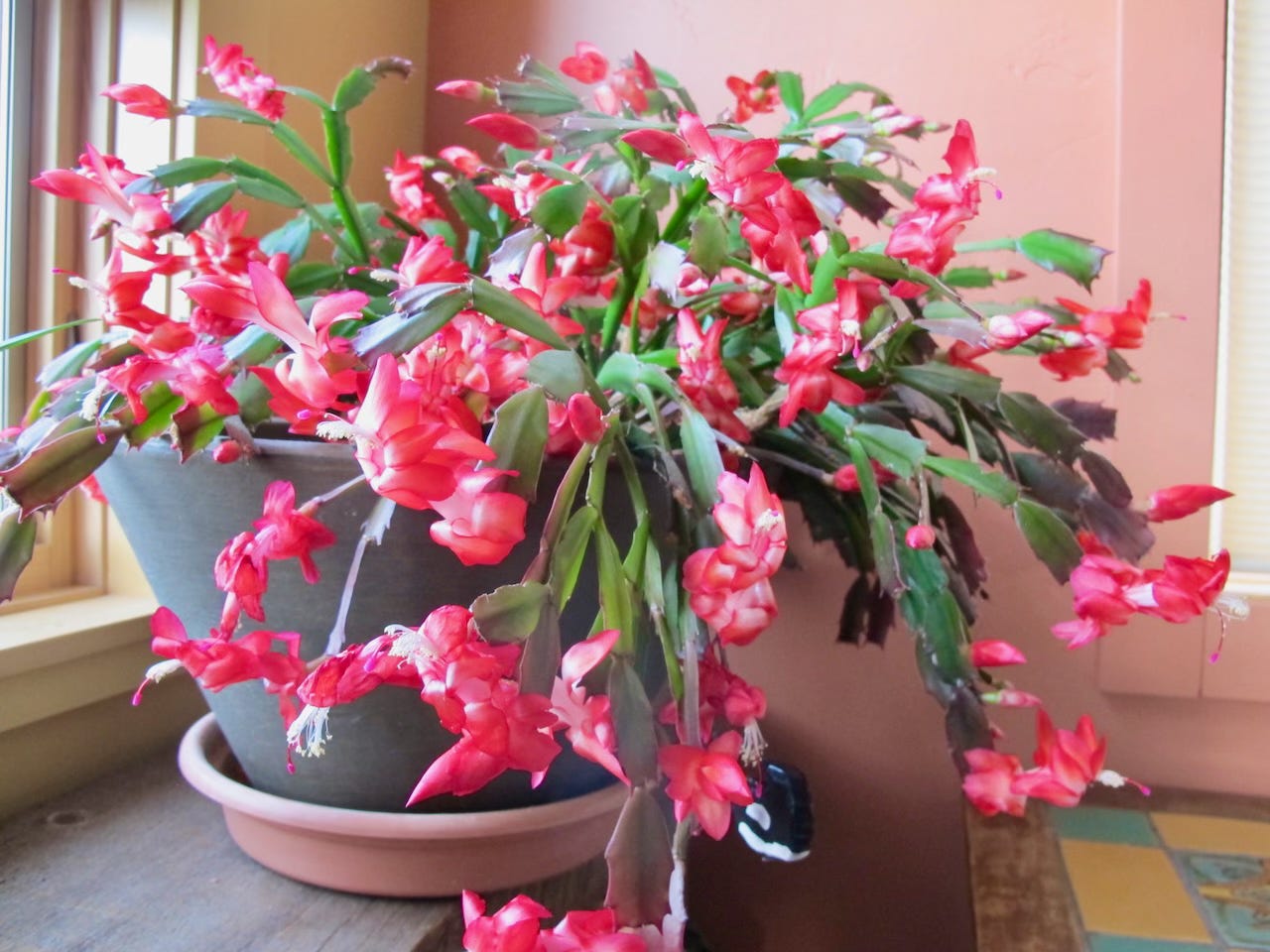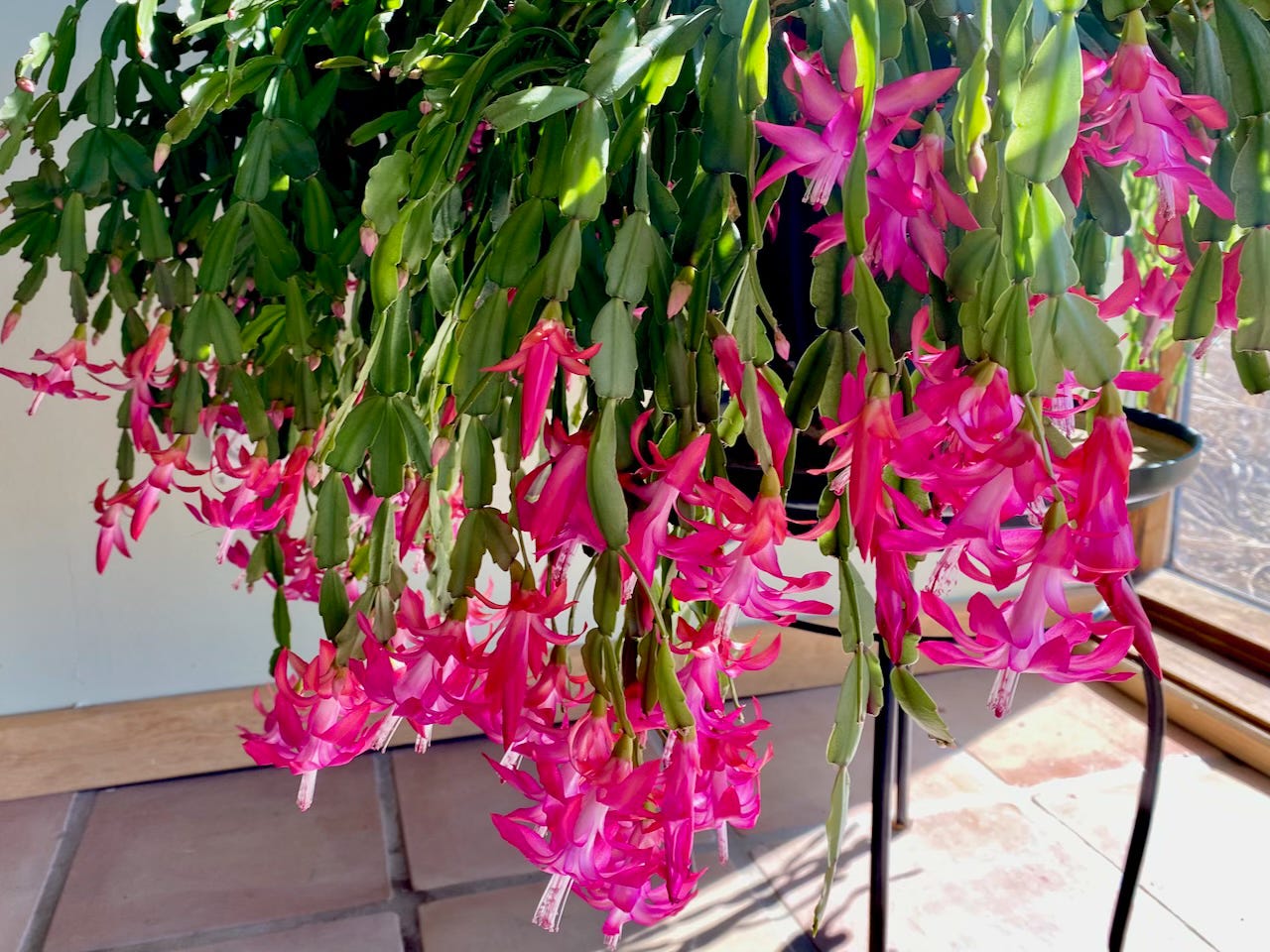I’m an unabashed plant geek, nerd, lover, whatever you want to call it. Plants are in many ways as much my “people” as humans. They are just as sensitive and fascinating if observed closely, and honestly, often much easier to get along with.
Despite my abiding affection for plants of all kinds, especially those native to the sagebrush sea of the intermountain West, I’ve never been a keeper of house plants. I prefer to appreciate my green and photosynthesizing relatives not as house pets, but engaged in the complexity of their interrelationships with other beings—pollinators, seed-dispersers, grazers, associates of all kinds.
I don’t keep plants as pets, with one exception: Schlumbergera, the genus known in the horticultural trade as Christmas cactus, even though these plants are not cacti, and in their native range in Brazil, where they’re called “Flor de Maio,” they bloom in May, not Christmas time.
(The common name is an example of both hemispheric and religious bias: The hybrids of Schlumbergera called Christmas cactus here do indeed bloom in what is winter in their native hemisphere south of the equator, but that is not Christmas-time. And Christmas itself is only one of the world’s winter holidays.)
My relationship with these epiphytes native to the dry tropical forests along Brazil’s southeastern coast is purely accidental and goes back to 1985 in Washington State, when my stepdaughter Molly, then six years old, wanted to buy her daddy, Richard, a plant to brighten up his state government office. She and I visited a florist, where we both fell in love with Scarlet, a slip of a Schlumbergera with three short stems and flowers as bright as the name Molly chose for her.
Scarlet lived happily on Richard’s desk until we moved to Boulder, Colorado, a few years later, where she relocated to our sunny apartment living room. She was joined by Violet, named for the delicate color at the base of her while flowers, and who we found abandoned in the yard.
Scarlet and Violet moved with us from Boulder to Iowa to New Mexico to our eventual long-term home in Salida, Colorado. Scarlet thrived in Salida, and in fact, grew so large that we took to decorating her many branches with Christmas lights and ornaments as our holiday “tree.” (Violet, always more delicate, bloomed every winter regardless.)
Until Richard was diagnosed with terminal brain cancer. When he began hospice care at home in September of 2011, Scarlet, then about 26 years old, was living on a flagstone shelf in our bedroom, in view of his hospital bed. Scarlet bloomed early that year, and Richard chuckled many times about the queer resemblance of her buds to parrot beaks, and admired her scarlet flowers. (Violet didn’t bloom that year.)
In late November, a few nights before Richard died, I woke in the dark to the sound of a crash. I got up groggily and searched the house, but couldn’t find the source of the noise.
In the morning, I saw Scarlet on the floor of our bedroom, her pot shattered and her stems broken. She had somehow fallen from her secure spot on the wide shelf six and a half feet above the floor. It felt like a leap of grief to me—she had always been Richard’s.
I gave away cuttings from the undamaged stems to friends and family, and potted up a piece for me. My slip of Scarlet rooted, but never really recovered from her fall and Richard’s death (nor did I, for that matter). Violet began to diminish that winter too.
We know from experimental data that plants can sense and respond physical touch and track light duration and color (they use the energy in sunlight to make their food, so that’s critical); they can remember and count, and communicate with volatile organic chemicals they produce. Who is to say they can’t feel love and grief too?
A few years later, I moved home to Cody in northwest Wyoming. That winter, my friend Jay’s dad died, and Jay and his wife Connie asked if I would like the enormous Schlumbergera from his dad’s house.
After my experience with Scarlet and Violet, I was hesitant. I finally agreed. Which is how Arabella, named for her abundance of hot-pink flowers that look like dancers caught in mid-twirl, came to live with me. She thrived in my Cody house, despite the disruption of a two-year basement-to-roof renovation project as I and my contractors brought that run-down mid-century modern house back to life.
Thank you for subscribing to Practicing Terraphilia! Join me in exploring how our daily actions affect us, our communities and the Earth that is our home.
Read on as a paid subscriber for Arabella’s story—she and I are the same age—and how plants can lift us as companions even in the hardest of times.
That first winter in Cody, I learned Arabella’s story from Jay and Connie. It begins—at least as we know it—in 1933, ninety years ago, when Jay’s mom was the teacher at the Hardpan School, a one-room school then on Southfork outside Cody. Jay’s mom often visited the McCulloughs, who owned the ranch where the school was, and admired the huge and clearly decades-old Christmas cactus in their ranch house.
Fast-forward to 1956, when Jay was in first grade at the Meeteetse School. His teacher, Mrs. Smith, who with her husband had bought the Hardpan Ranch from the McCulloughs, brought her class slips from the very same venerable Christmas cactus Jay’s mom had admired 23 years earlier. Mrs. Smith gave Jay two of those cuttings, and he gave one to his mom (Jay and Connie still have that huge Schlumbergera) and one to his grandmother, who lived with them.
The latter cutting is Arabella, who has thrived since Jay and Connie entrusted her to me seven years ago.
It hasn’t been easy for her, I am sure. Arabella and I have moved eight times since that winter as I have searched for what home means to me in this solo life I never imagined, from Cody to Santa Fe (one condo, one house), back to Cody (one house) and then to western Colorado (two houses) and finally back to my Santa Fe condo, and then one more move to settle in Casa Contenta.
Here, Arabella has her own south window and is beginning her Thanksgiving-to-April season of bloom. Over the next few months, this amazing Schlumbergera plant will open hundreds of flowers from the buds at the end of her arching stems.
I say that I live alone, but that’s not true: my days are graced by the company of a plant special to my dear friends and two generations of their family, and with a heritage that goes back many decades in Wyoming, the landscape that will always hold my heart.
There’s an even deeper connection: Arabella and I share a birth-year. We both came to be (or root, in her case) in 1956, which makes us each 67 years old. That’s old for a potted plant! Despite her age, Arabella has kept me company through some dark times and some long and difficult journeys.
And every year at this time when the days grow short and my mood dark—tomorrow is the 12th anniversary of Richard’s death—this amazing and resilient Schlumbergera brings me the gift of brilliant color and whimsy with her hundreds of magenta blooms.
I am fortunate to live in her company. Arabella’s steady presence helps me love this world and this life, hard times and all.
Thank you for reading and supporting Practicing Terraphilia. May your life be brightened by the companionship of other species!
Who are your plant companions? Please feel free to share, stack, re-stack or note this essay. Blessings!








Such a beautiful story, dear Susan. I'm so honored to have an offspring of your fantastic Arabella. She was just beginning to bloom when I left home, and I can't want to see her in all her glory when I get back home tomorrow. XOXOXO